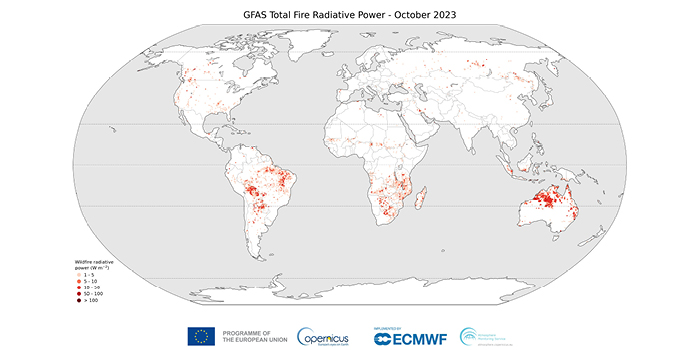The Copernicus Atmosphere Monitoring Service (CAMS) has been tracking seasonal fires around the tropics in the Southern Hemisphere since the beginning of August 2023 and seeing variability in wildfire emissions among different countries.
One of the regions experiencing significant large-scale fires, and associated emissions, particularly through October 2023, is northern Australia. The number and intensity of the fires (shown as daily total Fire Radiative Power (FRP)) for the country started to increase significantly during the first half of September 2023, with the highest levels of the season being registered in October 2023 with many fires in Western Australia, Northern Territory, Queensland, and, especially in the last days of October, New South Wales. Currently, the total estimated carbon emissions from fires for the period August 1 to October 31, 2023, are the highest since 2012, at around 120 megatons, while significant wildfire activity is still being reported.
The Amazon and Central parts of South America, despite widespread drought conditions, experienced generally below-average fire emissions between August and October 2023, with Brazil as a whole experiencing its lowest emissions since 2019. Nevertheless, significant wildfire activity has been occurring in parts of Northern Argentina, Paraguay and Bolivia. In Bolivia, high wildfire carbon emissions reached approximately 16 megatons for October 2023, making them the highest emissions for any October in the last two decades.
In Indonesia, the regions of Sumatra and southern Kalimantan generally experienced below-average fire emissions between August and October 2023, with Indonesia as a whole following the same trend, according to CAMS data. This happens despite the El Niño and positive phase of the Indian Ocean Dipole (IOD) leading to increased fire emissions for the Maritime Continent compared to the last three years. Both El Niño and the IOD typically enhance drier conditions across the region, which is related to a higher chance of wildfires to emerge. For example, the El Niño years of 2006 and 2015 and the positive IOD of 2019 are the years with higher wildfire emissions in Indonesia during the last 21 years.
Mark Parrington, senior scientist at CAMS, commented, “The predictions for El Niño this year have given us extra incentive for our emissions monitoring around the southern tropics since the beginning of August. We have observed increased fire emissions from Indonesia and the Amazon relative to recent years. While not reaching the extreme levels of the previous El Niño years, they have still produced significant amounts of smoke and degradation of air quality. The monitoring work we do in CAMS is essential for understanding the potential atmospheric impacts of fire emissions such as these when they are occurring.”
For more key extreme weather updates from the meteorological technology industry, click here
This article was originally posted on the ECMWF website, and can be viewed here.
Headline and opening paragraph adapted to suit the Meteorological Technology International website. Content shared under Creative Commons — Attribution 4.0 International — CC BY 4.0
![]()



